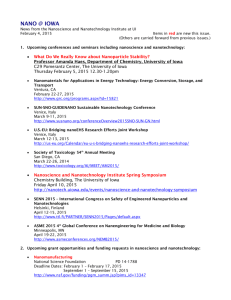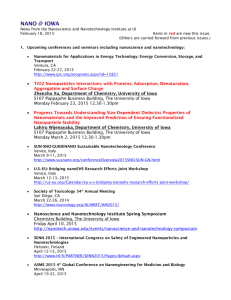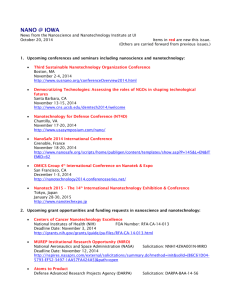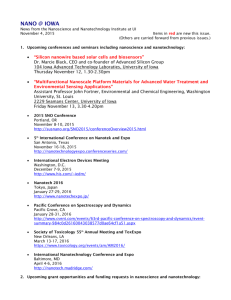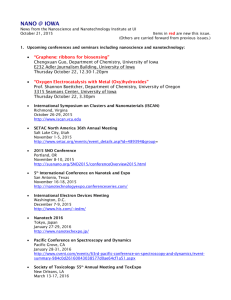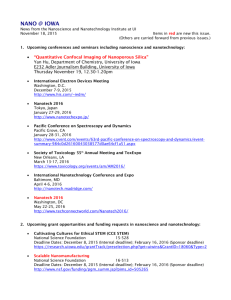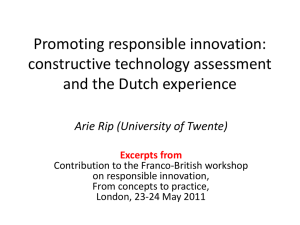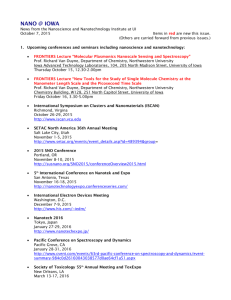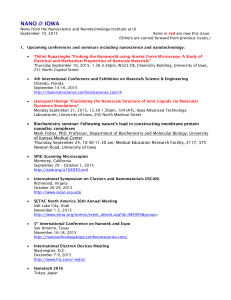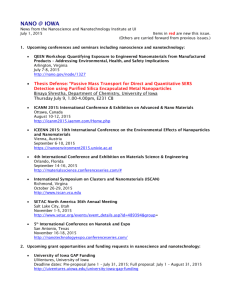March 4, 2015 - Nanoscience and Nanotechnology Institute
advertisement
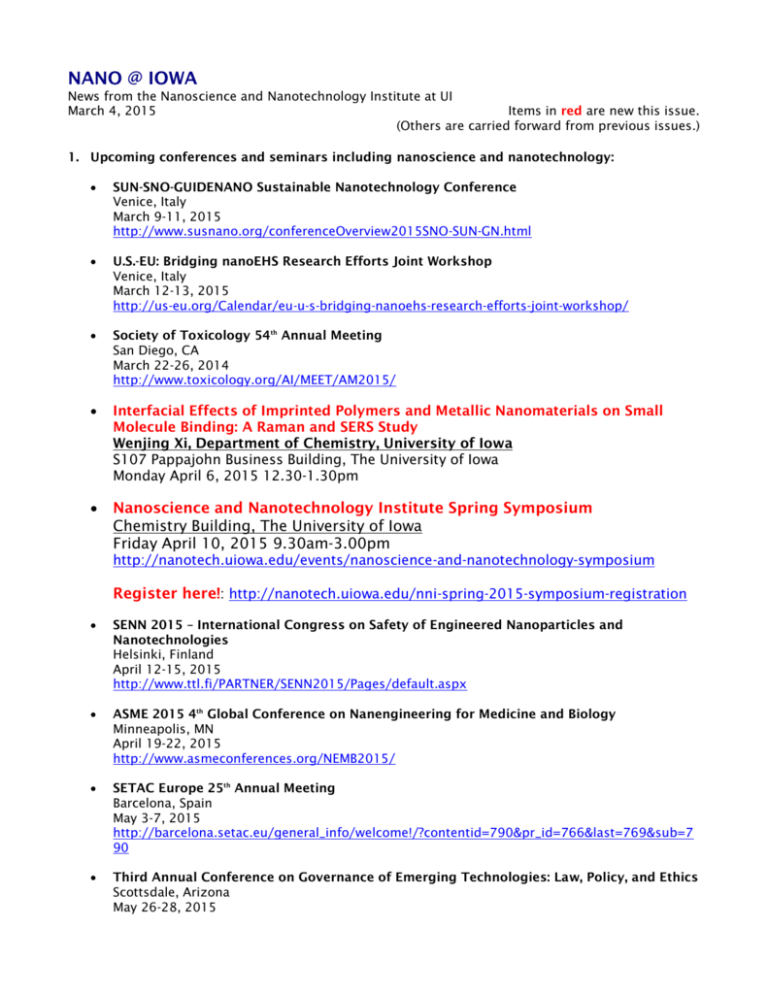
NANO @ IOWA News from the Nanoscience and Nanotechnology Institute at UI March 4, 2015 Items in red are new this issue. (Others are carried forward from previous issues.) 1. Upcoming conferences and seminars including nanoscience and nanotechnology: SUN-SNO-GUIDENANO Sustainable Nanotechnology Conference Venice, Italy March 9-11, 2015 http://www.susnano.org/conferenceOverview2015SNO-SUN-GN.html U.S.-EU: Bridging nanoEHS Research Efforts Joint Workshop Venice, Italy March 12-13, 2015 http://us-eu.org/Calendar/eu-u-s-bridging-nanoehs-research-efforts-joint-workshop/ Society of Toxicology 54th Annual Meeting San Diego, CA March 22-26, 2014 http://www.toxicology.org/AI/MEET/AM2015/ Interfacial Effects of Imprinted Polymers and Metallic Nanomaterials on Small Molecule Binding: A Raman and SERS Study Wenjing Xi, Department of Chemistry, University of Iowa S107 Pappajohn Business Building, The University of Iowa Monday April 6, 2015 12.30-1.30pm Nanoscience and Nanotechnology Institute Spring Symposium Chemistry Building, The University of Iowa Friday April 10, 2015 9.30am-3.00pm http://nanotech.uiowa.edu/events/nanoscience-and-nanotechnology-symposium Register here!: http://nanotech.uiowa.edu/nni-spring-2015-symposium-registration SENN 2015 – International Congress on Safety of Engineered Nanoparticles and Nanotechnologies Helsinki, Finland April 12-15, 2015 http://www.ttl.fi/PARTNER/SENN2015/Pages/default.aspx ASME 2015 4th Global Conference on Nanengineering for Medicine and Biology Minneapolis, MN April 19-22, 2015 http://www.asmeconferences.org/NEMB2015/ SETAC Europe 25th Annual Meeting Barcelona, Spain May 3-7, 2015 http://barcelona.setac.eu/general_info/welcome!/?contentid=790&pr_id=766&last=769&sub=7 90 Third Annual Conference on Governance of Emerging Technologies: Law, Policy, and Ethics Scottsdale, Arizona May 26-28, 2015 http://conferences.asucollegeoflaw.com/get2015/ 2. Upcoming grant opportunities and funding requests in nanoscience and nanotechnology: Project on Advanced Systems and Concepts for Countering WMD (PASCC) Naval Postgraduate School NPS-BAA-14-003 Deadline Date: March 31, 2015 http://www.nps.edu/Research/workingwithnps.html Seed Grants for Environmental Health Research on Contamination, Environmental Toxins Center for Health Effects of Environmental Contamination, University of Iowa Deadline Date: April 6, 2015 http://www.cheec.uiowa.edu/seedgrant/rfp.html Innovative Research in Cancer Nanotechnology National Institutes of Health FOA Number: PAR-14-285 Deadline Date: April 15, 2015; October 15, 2015 http://grants.nih.gov/grants/guide/pa-files/PAR-14-285.html Flexible Hybrid Electronics Manufacturing Innovation Institute Department of Defense FOA Number: FOA-RQKM-2015-0014 Deadline Date: May 29, 2015 http://www.grants.gov/web/grants/view-opportunity.html?oppId=271891 Industry/University Cooperative Research Centers Program National Science Foundation nsf13-594 Deadline Dates: Letter of Intent June 26, 2015; Full proposal September 25, 2015 http://www.nsf.gov/funding/pgm_summ.jsp?pims_id=5501&org=NNCO&sel_org=NNCO&from=f und Science, Technology, and Society National Science Foundation 15-506 Deadline Date: August 3, 2015 http://www.nsf.gov/funding/pgm_summ.jsp?pims_id=5324 NSF: Science of Science and Innovation Policy National Science Foundation PD 09-7626 Deadline Date: September 9, 2015 http://www.nsf.gov/funding/pgm_summ.jsp?pims_id=501084 Nanomanufacturing National Science Foundation PD 14-1788 Deadline Dates: September 1 – September 15, 2015 http://www.nsf.gov/funding/pgm_summ.jsp?pims_id=13347 Army Research Laboratory BAA for Basic and Applied Scientific Research Department of Defense FOA Number: W911NF-12-R-0011 Deadline Date: March 31, 2017 http://www.arl.army.mil/www/default.cfm?page=8 Image-guided Drug Delivery in Cancer National Institutes for Health (NIH) FOA Number: PA-09-253 Deadline Dates: January 25, May 25, and September 25, annually http://grants.nih.gov/grants/guide/pa-files/PA-09-253.html Development of Multifunctional Drug and Gene Delivery Systems National Institutes for Health (NIH) FOA Number: PA-10-048 Deadline Dates: February 5, June 5, and October 5, annually http://grants.nih.gov/grants/guide/pa-files/PAR-10-048.html Nanoscience and Nanotechnology in Biology and Medicine National Institutes of Health (NIH) FOA Number: PA-11-148 Deadline Dates: February 5, June 5, October 5, annually http://grants.nih.gov/grants/guide/pa-files/PA-11-148.html Bioengineering Nanotechnology Initiative National Institutes of Health (NIH) FOA Number: PA-10-149 Deadline Dates: April 5, August 5, December 5, annually http://www.grants.gov/web/grants/view-opportunity.html?oppId=53500 Cancer Diagnostic and Therapeautic Agents Enabled by Nanotechnology National Institutes of Health (NIH) FOA Number: PAR-10-286 Deadline Dates: April 5, August 5, December 5, annually http://grants.nih.gov/grants/guide/pa-files/PAR-10-286.html 3. Recent news and updates from NNI: Spring 2015 Nanoscience and Nanotechnology Symposium Online registration is now open! Friday April 10, 2015 all-day symposium with keynote speaker Dr Philip Demokritou, Associate Professor, Director, Laboratory for Environmental Health NanoScience (LEHNS), and Director, Center for Nanotechnology and Nanotoxicology Harvard School of Public Health who will talk on “In-vitro Dosimetry of Nanomaterials: Too complicated to consider, too important to ignore”. The schedule will be 9.30a.m.-12.30p.m. Talks, 12.30-1.30p.m. Lunch and 1.30-3.00p.m. Poster Session. The symposium will take place in the Chemistry Building.. Please find the registration form: http://nanotech.uiowa.edu/nni-spring-2015-symposium-registration 4. Highlights of some new interesting nanoscience and nanotechnology research and articles: Free-standing monolayers made from protein-bound gold nanoparticles Free-standing nanoparticle films are of great interest for technical applications, such as the development of nanoelectronic devices. In the journal Angewandte Chemie, Korean scientists have introduced very flexible and stable monolayers of gold nanoparticles made by a selfassembly process based on protein aggregation. The films were used to coat wafers up to 10 cm in diameter. The success of this new strategy relies on a small protein called α-synuclein, which is responsible for regulation of dopamine release in the brain, among other things. Incorrectly folded forms of this protein, which aggregate into poorly soluble fibril structures, seem to be involved in the development of neurodegenerative diseases such as Parkinson's. As devastating as this misfolding protein is to the brain, it has shown itself to be quite useful in the production of extensive films made of gold nanoparticles. http://phys.org/news/2015-02-free-standing-monolayers-protein-bound-gold-nanoparticles Ultra-thin nanowires can trap electron ‘twisters’ that disrupt superconductors Superconductor materials are prized for their ability to carry an electric current without resistance, but this valuable trait can be crippled or lost when electrons swirl into tiny tornadolike formations called vortices. These disruptive mini-twisters often form in the presence of magnetic fields, such as those produced by electric motors. To keep supercurrents flowing at top speed, Johns Hopkins scientists have figured out how to constrain troublesome vortices by trapping them within extremely short, ultra-thin nanowires. Their discovery was reported Feb. 18 in the journal Physical Review Letters. "We have found a way to control individual vortices to improve the performance of superconducting wires," said Nina Markovic, an associate professor in the Department of Physics and Astronomy in the university's Krieger School of Arts and Sciences. http://www.ecnmag.com/news/2015/02/ultra-thin-nanowires-can-trap-electron-twistersdisrupt-superconductors Silver nanoparticles adorn graphene to utilize light efficiently The most ubiquitous form of energy around us, light, is surprisingly underutilised. This is largely because photo-based devices are very inefficient at absorbing and then converting light into a useful electrical signal. Now researchers at the Indian Institute of Science (IIS) have designed a novel device based on graphene and metal nanoparticles that shows greatly enhanced response to light and is colour sensitive. This may foster applications like colour based ultra-sensitive photodetectors, efficient solar cells and detection of single molecules. Increasing the light-matter interaction is one of the foremost scientific quests today. It holds the key to a wide range of contemporary pursuits like solar energy generation, hybrid lightelectronic devices, cancer detection and many more. Many scientists have come up with numerous designs and methods to increase light absorption efficiency but much scope for improvement still remains. Writing in the journal Advanced Materials ("Ultrahigh Field Enhancement and Photoresponse in Atomically Separated Arrays of Plasmonic Dimers"), the IISc team show a device with a large number of silver nanoparticle pairs sitting on top of each other, all separated precisely by just one-third of a nanometer using graphene. All light interaction related properties are found enhanced in this device structure. Photocurrent (current generated due to light), for example, generated in this device is 200 times more than in one without silver nanoparticles. http://www.nanowerk.com/nanotechnology-news/newsid=39214.php New nanodevice defeats drug resistance Chemotherapy often shrinks tumors at first, but as cancer cells become resistant to drug treatment, tumors can grow back. A new nanodevice developed by MIT researchers can help overcome that by first blocking the gene that confers drug resistance, then launching a new chemotherapy attack against the disarmed tumors. The device, which consists of gold nanoparticles embedded in a hydrogel that can be injected or implanted at a tumor site, could also be used more broadly to disrupt any gene involved in cancer. "You can target any genetic marker and deliver a drug, including those that don't necessarily involve drug-resistance pathways. It's a universal platform for dual therapy," says Natalie Artzi, a research scientist at MIT's Institute for Medical Engineering and Science (IMES), an assistant professor at Harvard Medical School, and senior author of a paper describing the device in the Proceedings of the National Academy of Sciences the week of March 2. http://phys.org/news/2015-03-nanodevice-defeats-drug-resistance.html About NANO @ IOWA NANO @ IOWA is a biweekly electronic newsletter to inform faculty, staff and students about important news and events in nanoscience and nanotechnology. This newsletter is provided as a service of the Nanoscience and Nanotechnology Institute at UI (NNI). To subscribe to NANO @ IOWA, please send an email to NNI@uiowa.edu with subject line: Subscribe NANO @ IOWA. In the body of the message, type: (your first name) (your last name). To unsubscribe, send an email message to: NNI@uiowa.edu with subject line: Unsubscribe NANO @ IOWA. In the body of the message, type: (your first name) (your last name). If you have news for NANO @ IOWA, please e-mail jenny-nelson@uiowa.edu or call Jenny Nelson at 319-384-3292. http://nanotech.uiowa.edu
